
The First and Only Weekly Online Fanzine Devoted to the Life and Works of Edgar Rice Burroughs |
 |

The First and Only Weekly Online Fanzine Devoted to the Life and Works of Edgar Rice Burroughs |
 |
|
Chattering From The Shoulder No. 28
|
The dust jacket is a wrap-around painting of Tarzan, Akut (the ape) and Sheeta. The composition is a triangle with Tarzan at the apex with his right hand grasping an overhead branch. The ape's bullet head and torso forms another triangle at Tarzan's left, while the unspotted leopard (looking more like a mountain lion) stretches his great length across the bottom. The back cover reveals a black panther in a beautifully executed jungle scene. 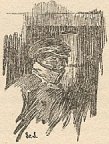 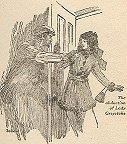 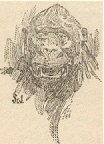 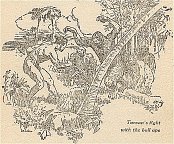 1. Chapter 1, p. 14 (small) a man in a slicker with the large collar covering his mouth and wearing a flat hat with a brim glance at the reader. I think he is Alexis Paulvitch hiding his identity from Tarzan. 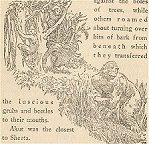 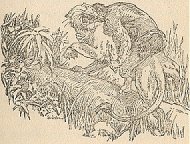 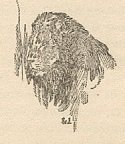 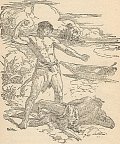 5. Chapter 4, p. 52-53 (a double-paged illustration) This outstanding piece is inserted into a jagged text to render the action. On the left-hand page the four apes are retreating into the jungle as Tarzan struggles upon the back of Sheeta on the right-hand page. Akut is near the middle of the scene, looking back at his savior. 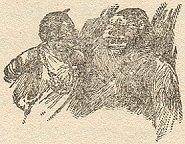 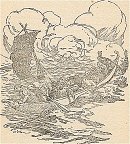 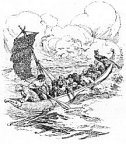  8. Chapter 5, p. 82 (small) A terrified Mugambi meets Akut, who has an arm around his shoulders.  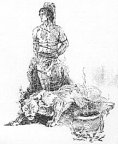 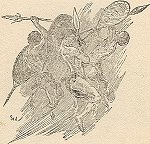 11. Chapter 7, p. 112 (full page) "Upon the bank before the river stood the Chief" A native wearing a leopard skin with the tail attached raises a spear horizontally above his head. He is a cannibal chief giving a signal to Rokoff that Tarzan is asleep in his village. He wears the same, odd, bone-like head gear as Mugambi -- probably just the way St. John drew natives at this time rather than an indication of his tribe. Also, he may have looked into the illustrations in Stanley's Through the Dark Continent. On page 40 of volume 2, a man of the Ugara is pictured with a similar head dress. Stanley notes on page 41, "The art of the coiffeur is better known here than in any portion of Africa east of Lake Tanganika. The "waterfall" and "back-hair" styles are superb, and the constructions are fastened with carved wooden or iron pins." 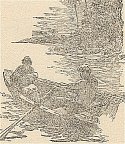 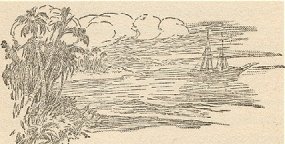 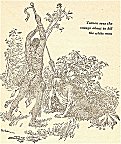 14. Chapter 9, p. 142 (half-page with wrap-around text) "Jane escapes from the Kincaid" Jane with her baby wrapped in a blanket is rowed away by the Swede, Anderssen. Half of the canoe disappears into the text in a clever design that causes the art of illustration to merge with the art of writing.   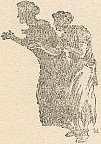 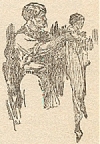 17. Chapter 10, p. 164 (small) The Swede is given a little drawing of himself as a young, healthy sailor. In the story, it is the moment of his death. 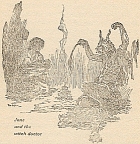 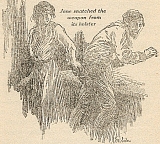 20. Chapter 12, p.192 (half-page) "Jane and the witch doctor" Jane kneels, sitting on her haunches holding a baby wrapped in a blanket. On the other side of a glowing fire and a small, earthen pot, the witch doctor kneels with one leg raised upon the skin of a great cat, dramatically raising both arms into the air. He wears a cap made of antelope horns and waves the tail of a zebra across the smoke of the fire, sprinkling a few drops of liquid over the baby's face.   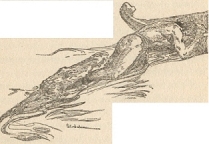 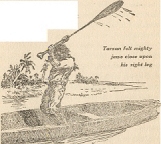 22. Chapter 13, p. 209 (small) Jane asleep in the crotch of a tree (which occurs on p. 216). The moon shines on her face. The bole of the tree extends toward the bottom of the page, forming a pleasing Y shape to the little picture. It's really quite a remarkable drawing for its size. St. John was a master at suggesting moods with a minimum of effort. I suspect that all of these small drawings were much reduced in printing since the lines blur together, which was definitely not part of his clean-lined style. And again, the thin, rag-like paper of my Burt edition is not the best for reproductions. 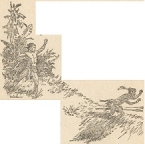 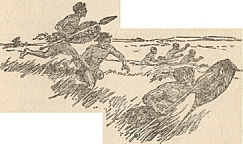 25. Chapter 16, p. 248-249 (two-page spread wrapped by the text) Tarzan, waving his arms and giving the awful cry of the bull-ape frightens bellicose natives. This is another effective two-page spread. Tarzan is near the top of the left-hand page while the running natives are mostly on the right-hand, running downhill to the bottom of the page. Again, the action in the text takes place in the previous page. These two-page scenes are very charming and give the story added movement. 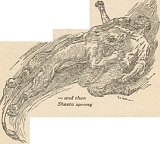 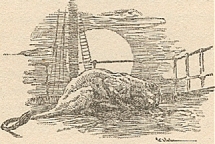  26. Chapter 17, p. 266 (middle of page, text is wrapped) " -- and then Sheeta sprang" Sheeta springs upon Rokoff. The cat extends in a diagonal across the entire page toward Rokoff on his knees already knocked backwards by the weight of the beast. There is a great flurry of outstretched arms, legs and Sheeta's tail accented by St. John's flowing hatch lines that surround the picture. 27. Chapter 17, p. 269 (small) Sheeta gnaws on Rokoff's bones in the moonlight upon the deck of the Kincaid. Grisly (and maybe gristly). 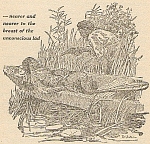 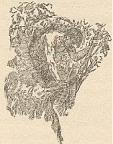 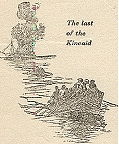 29. Chapter 18, p. 278 (middle of page) " -- nearer and nearer to the breast of the unconscious lad" Paulvitch points a pistol at a sleeping Mosula native asleep in his canoe. In the story, he kills the lad, but the sleeping boy in the waterlilied, reed swamp is very charming, only emphasizing Paulvitch's evil nature. There is a great deal of psychological depth in this simple drawing. 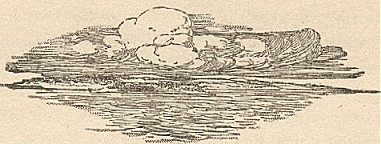 32. Chapter 20, p. 298 (small) (a chapter heading) In contrast to St. John's brilliant chapter headings for The Return of Tarzan, the illustrations for Beasts are either among the text or at the end of the chapter; thus this chapter heading of a little drawing of Jungle Island seen across the expanse of the sea, under those billowing clouds that we saw again and again throughout the book, is doubly effective. It comes as a surprise and highlights again the great variety of drawings he made for this book. It's a "throwaway" oval drawing of a few lines that hits like a ton of brinks when we read the title of the chapter "Jungle Island Again." 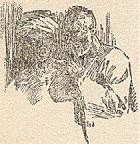 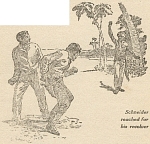  33. Chapter 20, p. 304 (small) Kai Shang, a tall, balding man dressed in a flowing robe whispers into the ear of Momulla the Maori, who is turbaned and bare-chested. We see only their torsos from the front, Kai Shang's hand is on Momulla's shoulder. 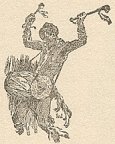 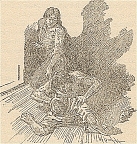 36. Chapter 20, p. 316 (small) A standing native holding beaters with both arms raised is pounding a large drum that he holds crosswise on a thong attached to his neck. Native drums seem to pound in our ears when we think of Africa. Stanley in his Through the Dark Continent writes of the drumming heard before native attacks, 32 of them sustained on his approach to the Congo (252 ). "Though hostilities has ceased, the drumming continued with unabated fury; bass and kettle-drums gave out a thunderous sound, which must have been heard to an immense distance" (206). 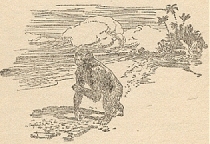 38. Chapter 21, p. 337 (bottom half of page) A sad Akut strides across the sand of Jungle Island; he pauses with one arm half raised in a pathetic waving goodbye. . . . Jane and Tarzan, standing upon the deck, saw the lonely figure of the shaggy anthropoid, motionless upon the surf-beaten sands of Jungle Island." It is a touching illustration, and the reader feels the same sadness that this great novel is over. |
|
visit the ERB C.H.A.S.E.R. ENCYCLOPEDIA angelfire.com/trek/chaser The St. John illustrations used here were re-sized from the originals for ease of loading For larger-sized versions of these St. John illustrations see ERBzine 0485 and ERBzine 0486 |
|
Nkima Chat Series II Intro |
Chat 26: Tarzan of the Apes African Adv. Story |
Chat 27: Return of Tarzan Some Thoughts. . . |
|
Chat 28: Beasts of Tarzan St. John Illustrations |
Chat 29: Son of Tarzan Thoughts About. . . |
Chat 30: Tarzan and the Jewels of Opar Two Psychological Investigations |
|
Chat 31: Jungle Tales of Tarzan I A Novelistic Reading I |
Chat 32: Jungle Tales of Tarzan II Novelistic Reading: 12 Lunar Labors |
Chat 33: Tarzan the Untamed: Imaginative Deaths of Enemies |
|
Chat 34: Tarzan the Untamed: ERB's Book of the Lion |
Chat 35: OFs of OB |
Chat 36: Tarzan and the War Against the Hun |
|
Chat 37: The Convolutions of Tarzan and the Golden Lion |
Chat 38: Tarzan and the Ant Men An Infantile Romance |
Chat 39: Tarzan and the Ant Men Lacanian Analysis |
|
Chat 40: Tarzan and the Tarzan Twins A Story for Children of All Ages |
Nkima'sChattering From The Shoulder Main Introduction and Contents Page |
Chat 41: Tarzan the Magnificent Tarzan and the Magic Women Pt. 1 |
![]()
![]()
![]()
Issue
0667

BILL
HILLMAN
Visit
our thousands of other sites at:
BILL
AND SUE-ON HILLMAN ECLECTIC STUDIO
ERB
Text, ERB Images and Tarzan® are ©Edgar Rice Burroughs, Inc.-
All Rights Reserved.
All
Original Work ©1996-2002/2010 by Bill Hillman and/or Contributing
Authors/Owners
No
part of this web site may be reproduced without permission from the respective
owners.